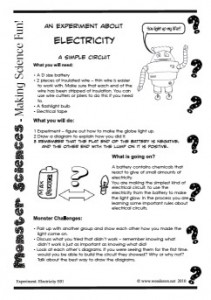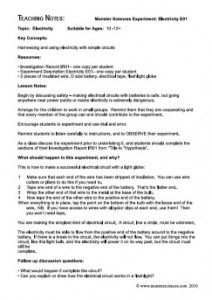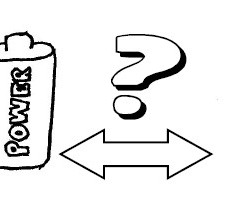Learn how electrical circuits work by experimenting to see if you can get a light bulb to shine!
 |
 |
An Electricity Science Experiment – A Simple Circuit
What you will need:
• A D size battery
• 2 pieces of insulated wire – thin wire is easier to work with. Make sure that each end of the wire has been stripped of insulation. You can use wire cutters or pliers to do this if you need to.
• A flashlight bulb
• Electrical tape
What you will do:
1 Experiment – figure out how to make the globe light up.
2 Draw a diagram to explain how you did it.
3 Remember that the flat end of the battery is negative, and the other end with the lump on it is positive.
What is going on?
A battery contains chemicals that react to give of small amounts of electricity.
You are making the simplest kind of electrical circuit, to use the electricity from the battery to make the light glow. In the process you are learning some important rules about electrical circuits.
Monster Challenges:
• Pair up with another group and show each other how you made the light come on.
• Discuss what you tried that didn’t work – remember knowing what didn’t work is just as important as knowing what did!
• Look at each other’s diagrams. If you were seeing them for the first time, would you be able to build the circuit they showed? Why or why not? Talk about the best way to draw the diagrams.
Teaching Notes: Monster Sciences Experiment: Electricity E01
Topic:
Electricity
Key Concepts:
Harnessing and using electricity with simple circuits
Resources:
• Investigation Record IR01– one copy per student
• Experiment Description Electricity E01– one copy per student
• 2 pieces of insulated wire, D size battery, electrical tape, flashlight globe
Lesson Notes:
Begin by discussing safety – making electrical circuits with batteries is safe, but going anywhere near power points or mains electricity is extremely dangerous.
Arrange for the children to work in small groups. Remind them that they are cooperating and that every member of the group can and should contribute to the experiment.
Encourage students to experiment and use trial and error.
Remind students to listen carefully to instructions, and to OBSERVE their experiment.
As a class discuss the experiment prior to undertaking it, and students should complete the
sections of their Investigation Report IR01 from ”Title to “Hypothesis”.
What should happen in this experiment, and why?
This is how to make a successful electrical circuit with a light globe:
1 Make sure that each end of the wire has been stripped of insulation. You can use wire cutters or pliers to do this if you need to.
2 Tape one end of a wire to the negative end of the battery. That’s the flatter end.
3 Wrap the other end of that wire to the metal at the base of the bulb.
4 Now tape the end of the other wire to the positive end of the battery.
When everything is in place, tap the point on the bottom of the bulb with the loose end of the wire. NB: If you have access to wires with alligator clips at each end, use them! Then you won’t need tape.
You are making the simplest kind of electrical circuit. A circuit, like a circle, must be unbroken.
The electricity must be able to flow from the positive end of the battery around to the negative
battery. If there is a break in the circuit, the electricity will not flow. You can put things into the
circuit, like this light bulb, and the electricity will power it on its way past, but the circuit must still be
complete.
Follow up discussion questions:
• What would happen if complete the circuit?
• Can you explain or draw how the electrical circuit works in a flashlight?
© www.monstersciences.com




